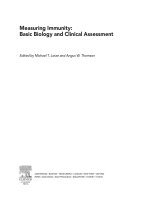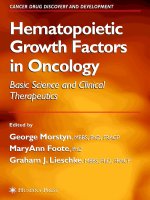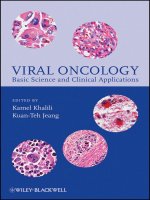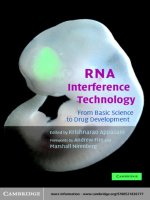Adrenocortical Carcinoma Basic Science and Clinical Concepts ppt
Bạn đang xem bản rút gọn của tài liệu. Xem và tải ngay bản đầy đủ của tài liệu tại đây (12.68 MB, 562 trang )
Adrenocortical Carcinoma
Gary D. Hammer · Tobias Else
Editors
Adrenocortical Carcinoma
Basic Science and Clinical Concepts
1 3
Editors
Gary D. Hammer, MD, Ph.D.
Mille Schembechler Professor of Adrenal
Cancer
Director – Endocrine Oncology Program
Director – Center for Organogenesis
University of Michigan Health System
University of Michigan
Tobias Else, MD
Department of Internal Medicine
Division of Metabolism, Endocrinology
& Diabetes
University of Michigan Health System
University of Michigan
ISBN 978-0-387-77235-6 e-ISBN 978-0-387-77236-3
DOI 10.1007/978-0-387-77236-3
Springer New York Dordrecht Heidelberg London
Library of Congress Control Number: 2010934103
© Springer Science+Business Media, LLC 2011
All rights reserved. This work may not be translated or copied in whole or in part without the written
permission of the publisher (Springer Science+Business Media, LLC, 233 Spring Street, New York,
NY 10013, USA), except for brief excerpts in connection with reviews or scholarly analysis. Use in
connection with any form of information storage and retrieval, electronic adaptation, computer software,
or by similar or dissimilar methodology now known or hereafter developed is forbidden.
The use in this publication of trade names, trademarks, service marks, and similar terms, even if they are
not identified as such, is not to be taken as an expression of opinion as to whether or not they are subject
to proprietary rights.
While the advice and information in this book are believed to be true and accurate at the date of going
to press, neither the authors nor the editors nor the publisher can accept any legal responsibility for any
errors or omissions that may be made. The publisher makes no warranty, express or implied, with respect
to the material contained herein.
Printed on acid-free paper
Springer is part of Springer Science+Business Media (www.springer.com)
Preface
Adrenocortical carcinoma (ACC) is a disease that most physicians, including many
endocrinologists, will rarely, if ever, diagnose or let alone treat during the course
of their medical practice. Medical textbooks of endocrinology and oncology rarely
dedicate an entire chapter to this disease entity. The pursuit of research and clini-
cal excellence in uncommon diseases is extremely challenging because of a lack of
research prioritization, nonexistent treatment guidelines and overall paucity of coor-
dination between researchers and physicians. ACC is one such disease where no
infrastructure for a unified research agenda and no consensus treatment guidelines
had been developed.
While a number of international meetings over the past two decades have indeed
focused on adrenal tumors in the context of hormone excess (Cushing’s syndrome,
hyperaldosteronism, and pheochromocytoma), few have exclusively catered to the
science and clinical care of ACC and those afflicted with the disease. With only
a single FDA-approved drug for ACC (mitotane – a derivative of the pesticide
DDT), institutional experiences varied widely until recently when historic biases
have slowly yielded to data-driven treatment strategies. A large part of t he impetus
for this push has come from Europe, where the availability of country-wide inte-
grated networks for treatment has allowed a small number of centers in Italy, France,
and Germany (among others) to develop specific expertise and specific treatment
protocols for this rare disease.
In an attempt to facilitate coordination of global efforts, a consensus conference
was organized and held at the University of Michigan in September 2003. At that
meeting, an international group of physicians and scientists with research interest
and clinical expertise in ACC set up initial guidelines for the diagnosis and treat-
ment of ACC. Three principles emerged. Successful treatment of ACC demands
coordinated care in the context of a multidisciplinary team dedicated to the dis-
ease. Future therapies for ACC need to be predicated on hypothesis-driven research
based on a thorough analysis of tumor biology. Lastly, major advancement in the
field demands national and international collaborative networks to facilitate anal-
ysis of large datasets and coordinate future clinical trials. The FIRM-ACT (First
International Randomized Trial in locally advanced and Metastatic Adrenocortical
Cancer Treatment) that coordinated over 35 ACC centers in a single multina-
tional trial set precedence for the actualization of these principles. The Second
v
vi Preface
International Adrenal Cancer Symposium: Clinical and Basic Science held at the
University of Michigan in March 2008 built upon the momentum of the 2003
consensus meeting and the successful development of a large international ACC
network through the FIRM-ACT trial.
Over the past decade, the ACC research community has grown to a critical mass
with new data emerging in the laboratory and clinic. In times of electronic pub-
lications we routinely rely on journal articles and expert reviews on both clinical
and research topics. While such publications are informative, when approached by
Springer about the possibility of editing such a textbook, we became convinced that
the time had come to compile the accumulated clinical and basic science knowledge
of 50 years of active research on this rare cancer into a concise medical textbook.
The overall goal of this book is therefore to provide definitive reference material for
scientists and clinicians, to introduce trainees to concepts of ACC management, and
to stimulate further research, future collaborations, and networking.
As opposed to a solitary review article, a textbook with multiple chapters
dedicated to discrete topics in the field provides contributors the opportunity to
objectively r eview historic data and detail the current state of clinical care and
research accomplishments. While this is a major advantage of a textbook, it is also a
major challenge for a book that focuses solely on a rare cancer where data are scant.
In editing this book, we tried to ensure that each individual chapter covers well-
established knowledge in the area, but also allows room for expert opinion. Lastly,
because ACC has been linked to s everal genetic disorders that usually escape discus-
sion in a focused review of adrenal tumors, the various syndromes will be discussed
in their entirety in separate chapters. The 32 Chapters of the 9 Sections are authored
by the scientific and clinical leaders in the field.
With publication of this first edition, the editors want to extend special thanks
to our colleagues within the ACC community, the contributors, Rachel, Todd and
Lesley of the editorial staff at Springer Publishing House, and Lisa K. Byrd of the
University of Michigan.
We are hopeful that this first edition of the textbook provides an intellectual plat-
form for the continued coalescence and dissemination of knowledge on ACC in
future editions. Both the authors and editors welcome comments and recommenda-
tions for improvement in writing or via electronic mail. The editors’ and authors’
institutional and e-mail addresses are given in the contributor’s section.
Ann Arbor, Michigan Gary Hammer
November 2010 Tobias Else
Contents
Part I History of Adrenocortical Carcinoma Research
and Clinical Care
1 The History of Adrenocortical Carcinoma Treatment – A
Medical Perspective 3
David E. Schteingart
2 The History of Adrenocortical Carcinoma Treatment – A
Surgical Perspective 9
Norman W. Thompson
Part II Epidemiology, Presentation and Diagnosis
3 Epidemiology of Adrenocortical Carcinoma 23
Martin Fassnacht and Bruno Allolio
4 Clinical Presentation and Initial Diagnosis 31
Bruno Allolio and Martin Fassnacht
5 Diagnostic Approach to Incidentaloma 49
Holger S. Willenberg and Stefan R. Bornstein
Part III Imaging
6 Computed Tomography/Magnetic Resonance Imaging
of Adrenocortical Carcinoma 67
Melvyn Korobkin, Anca M. Avram, and Hero K. Hussain
7 Functional Imaging of Adrenocortical Carcinoma 85
Anca M. Avram and Stephanie Hahner
Part IV Pathology
8 Classical Histopathology and Immunohistochemistry 107
Wolfgang Saeger
vii
viii Contents
9 Cellular and Molecular Pathology of Adrenocortical
Carcinoma 127
Tobias Else
Part V Genetic and Molecular Aspects
10 Overview of Genetic Syndromes Associated
with Adrenocortical Cancer 153
Tobias Else
11 Li–Fraumeni Syndrome 173
David Malkin
12 TP53 Molecular Genetics 193
Gerard P. Zambetti and Raul C. Ribeiro
13 Telomeres and Telomerase in Adrenocortical Carcinoma 207
Tobias Else and Peter J. Hornsby
14 Beckwith–Wiedemann Syndrome 227
Michael DeBaun and Jennifer Horst
15 The Insulin-Like Growth Factor System in Adrenocortical
Growth Control and Carcinogenesis 235
Christian Fottner, Ina M. Niederle, and Matthias M. Weber
16 WNT/β-Catenin Signaling in Adrenocortical Carcinoma 263
Sébastien Gaujoux, Frédérique Tissier, and Jérôme Bertherat
Part VI Models of Adrenocortical Cancer
17 Adrenocortical Stem and Progenitor Cells:
Implications for Cancer 285
Joanne H. Heaton and Gary D. Hammer
18 Adrenocortical Cell Lines 305
Jeniel Parmar, Anita Kulharya, and William Rainey
19 Mouse Models of Adrenal Tumorigenesis 325
Felix Beuschlein
Part VII Therapies
20 Overview of Treatment Options for Adrenocortical Carcinoma . . 343
Gary D. Hammer
21 Chemotherapy 351
Alfredo Berruti, Paola Sperone, Paola Perotti, Anna Ferrero,
Luigi Dogliotti, and Massimo Terzolo
22 Mitotane 369
Massimo Terzolo, Arianna Ardito, Barbara Zaggia, Silvia De
Francia, and Fulvia Daffara
Contents ix
23 Pharmacotherapy for Hormone Excess in Adrenocortical
Carcinoma 383
Richard J. Auchus
24 Surgery for Adrenocortical Carcinoma 403
James T. Broome, Barbra S. Miller, Paul G. Gauger,
and Gerard M. Doherty
25 Radiation Therapy for Adrenocortical Carcinoma 427
Aaron Sabolch and Edgar Ben-Josef
26 Follow-Up and Monitoring of Adrenocortical Carcinoma 443
Britt Skogseid and Gerard M. Doherty
Part VIII Unique Cohorts and Future Perspectives
27 Aldosterone-Producing Adrenocortical Carcinoma 457
Anna Patalano, Maria V. Cicala, and Franco Mantero
28 Adrenocortical Cancer in Children 467
Carlos Rodriguez-Galindo, Gerard P. Zambetti,
and Raul C. Ribeiro
29 Genome-Wide Studies in Adrenocortical Neoplasia 483
Thomas J. Giordano
30 New Strategies for the Treatment of Adrenocortical
Carcinoma 493
Lawrence S. Kirschner
Part IX Adrenal Cancer Networks and Registries
31 The Dutch Adrenal Network 517
Ilse G.C. Hermsen, Yvonne E. Groenen, and Harm R. Haak
32 The ENS@T Initiative 521
Xavier Bertagna
Index 533
Contributors
Bruno Allolio Department of Internal Medicine I, Endocrine and Diabetes Unit,
University of Würzburg, Josef-Schneider-Str. 2, 97080 Würzburg, Germany,
Arianna Ardito Department of Clinical and Biological Sciences, Medicina
Interna 1, AOU San Luigi Gonzaga, University of Turin, Regione Gonzole, 10,
10043 Orbassano, Italy,
Richard J. Auchus Division of Endocrinology and Metabolism, Department of
Internal Medicine, UT Southwestern Medical Center Dallas, 5323 Harry Hines
Boulevard, Dallas, TX 75390, USA,
Anca M. Avram Division of Nuclear Medicine/Radiology, University of
Michigan Health System, University of Michigan, 1500 East Medical Center
Drive, Ann Arbor, MI 48105, USA,
Edgar Ben-Josef Department of Radiation Oncology, University of Michigan
Health System, University of Michigan, 1500 East Medical Center Drive, Room
UHB2C490, Ann Arbor, MI 48109-0010, USA,
Alfredo Berruti Oncologia Medica, Azienda Ospedaliero Universitaria San Luigi,
Regione Gonzole, 10, 10043 Orbassano, Italy,
Jérôme Bertherat Endocrinology, Metabolism and Cancer Department, Institut
Cochin, Descartes University, INSERM U567, CNRS UMR8104, Paris France;
Reference center for rare adrenal disorders, Assistance Publique Hôpitaux de Paris,
Hôpital Cochin, Paris Descartes University, 27 Rue du Faubourg Saint-Jacques,
75014 Paris, France,
Xavier Bertagna Endocrinology Department, Cochin Hospital, Paris, France;
National Network COMETE, INCa, Paris, France; European Network for the
Study of @drenal Tumors (ENS@T), 27 Rue du Faubourg Saint-Jacques, 75014
Paris, France,
Felix Beuschlein Department of Medicine, Endocrine Research, University
Hospital Innenstadt, Ziemssenstr. 1, 80336 Munich, Germany,
xi
xii Contributors
Stefan R. Bornstein Department of Medicine, Carl Gustav Carus Medical School,
University of Dresden, Fetscherstraße 74, 01307 Dresden, Germany,
James T. Broome Vanderbilt Endocrine Surgery Center, Vanderbilt University,
597 Preston Research Building, 2220 Pierce Ave, Nashville, TN, USA,
Maria V. Cicala Division of Endocrinology, Department of Medical and Surgical
Sciences, University of Padua, Via Ospedale 105, 35128 Padova, Italy,
Fulvia Daffara Department of Clinical and Biological Sciences, Medicina
Interna 1, AOU San Luigi Gonzaga, University of Turin, Regione Gonzole, 10,
10043 Orbassano, Italy,
Silvia De Francia Department of Clinical and Biological Sciences, Farmacologia,
AOU San Luigi Gonzaga, University of Turin, Regione Gonzole, 10, 10043
Orbassano, Italy,
Michael DeBaun Division of Pediatric Hematology-Oncology, Department of
Pediatrics, Washington University School of Medicine, 660 South Euclid Avenue,
Box 8067, St. Louis, MO 63110-1093, USA,
Luigi Dogliotti Oncologia Medica, Azienda Ospedaliero Universitaria San Luigi,
Regione Gonzole 10, 10043 Orbassano, Italy,
Gerard M. Doherty Department of Surgery, University of Michigan Health
System, The University of Michigan, 2920 Taubman Center, 1500 East Medical
Center Drive, Ann Arbor, MI 48109, USA,
Tobias Else Department of Internal Medicine – Division of Metabolism,
Endocrinology & Diabetes, University of Michigan Health System, University of
Michigan, Domino’s Farms, Lobby C, Suite 1300, 24 Frank Lloyd Wright Drive,
PO Box 451, Ann Arbor, MI 48106, USA,
Martin Fassnacht Department of Internal Medicine I, Endocrine and Diabetes
Unit, University Hospital of Würzburg, Josef-Schneider-Str. 2, 97080 Würzburg,
Germany,
Anna Ferrero Oncologia Medica, Azienda Ospedaliero Universitaria San Luigi,
Regione Gonzole 10, 10043 Orbassano, Italy,
Christian Fottner Schwerpunkt Endokrinologie und Stoffwechselerkrankungen,
I. Medizinische Klinik und Poliklinik, Universitätsmedizin, Johannes Gutenberg
Universität Mainz, Langenbeckstrasse 1, 55131 Mainz, Germany,
Paul G. Gauger Department of Surgery, University of Michigan Health System,
University of Michigan, 1500 East Medical Center Drive, Ann Arbor, MI 48109,
USA,
Contributors xiii
Sébastien Gaujoux Endocrinology, Metabolism and Cancer Department, Institut
Cochin, INSERM U567, CNRS UMR8104, Paris, France; Department of Digestive
and Endocrine Surgery, Assistance Publique Hôpitaux de Paris, Hôpital Cochin,
Paris Descartes University, 27 Rue du Faubourg Saint-Jacques, 75014 Paris,
France,
Thomas J. Giordano Departments of Pathology and Internal Medicine,
University of Michigan Health System, University of Michigan, 1500 East Medical
Center Drive, Ann Arbor, MI 48109, USA,
Yvonne E. Groenen Department of Internal Medicine, Máxima Medical Centre,
Ds. Th. Fliednerstraat 1, PO Box 90052, 5600 PD Eindhoven, Leiden University
Medical Centre, Leiden, The Netherlands,
Stephanie Hahner Department of Internal Medicine I, Endocrine and Diabetes
Unit, University Hospital of Würzburg, Josef-Schneider-Str. 2, 97080 Würzburg,
Germany,
Gary D. Hammer Endocrine Oncology Program – Comprehensive Cancer
Center, Department of Internal Medicine – Division of Metabolism, Endocrinology
& Diabetes, Department of Molecular & Integrative Physiology, Department of
Cell & Developmental Biology, University of Michigan, 1528 BSRB, 109 Zina
Pitcher PI., Ann Arbor, MI 48109-2200, USA,
Harm R. Haak Department of Internal Medicine, Máxima Medical Centre, Ds.
Th. Fliednerstraat 1, PO Box 90052, 5600 PD Eindhoven, Leiden University
Medical Centre, Leiden, The Netherlands,
Joanne H. Heaton Department of Internal Medicine, Division of Metabolism,
Endocrinology & Diabetes, University of Michigan Medical School, 109 Zina
Pitcher Place, 1680 BSRB, Ann Arbor, MI 48109, USA,
Ilse G.C. Hermsen Department of Internal Medicine, Máxima Medical Centre,
Ds. Th. Fliednerstraat 1, PO Box 90052, 5600 PD Eindhoven, Leiden University
Medical Centre, Leiden, The Netherlands,
Peter J. Hornsby Department of Physiology and Barshop Institute for Longevity
and Aging Studies, University of Texas Health Science Center, 15355 Lambda
Drive, San Antonio, TX 78245, USA,
Jennifer Horst Department of Pediatrics, Washington University School of
Medicine, Washington University, One Brookings Drive, St. Louis, MO 63130,
USA,
Hero K. Hussain Department of Radiology, University of Michigan Health
System, University of Michigan, 1500 East Medical Center Drive, Ann Arbor, MI
48105, USA,
Lawrence S. Kirschner Division of Endocrinology, Diabetes and Metabolism,
Department of Internal Medicine and Department of Molecular Virology,
xiv Contributors
Immunology and Medical Genetics, The Ohio State University, Columbus Enarson
Hall 154 W. 12th Avenue, Columbus, OH 43210, USA,
Melvyn Korobkin Department of Radiology, University of Michigan Health
System, University of Michigan, 1500 East Medical Center Drive, Ann Arbor, MI
48105, USA,
Anita Kulharya Department of Pediatrics, Pathology and Cytogenetics, Medical
College of Georgia, 1120 15th Street, BG-1071, Augusta, GA 30912, USA,
David Malkin Division of Hematology/Oncology, Department of Pediatrics, The
Hospital for Sick Children, University of Toronto, 555 University Avenue, Toronto,
ON M5G 1X8, Canada,
Franco Mantero Division of Endocrinology, Department of Medical and Surgical
Sciences, University of Padua, Via Ospedale 105, 35128 Padova, Italy,
Barbra S. Miller Department of Surgery, University of Michigan Health System,
University of Michigan, 1500 East Medical Center Drive, Ann Arbor, MI 48109,
USA,
Ina M. Niederle Schwerpunkt Endokrinologie und Stoffwechselerkrankungen,
I. Medizinische Klinik und Poliklinik, Universitätsmedizin, Johannes Gutenberg
Universität Mainz, Langenbeckstrasse 1, 55131 Mainz, Germany,
Jeniel Parmar Department of Physiology, Medical College of Georgia, 1120 15th
Street Room CA3091, Augusta, GA 30912, USA,
Anna Patalano Division of Endocrinology, Department of Medical and Surgical
Sciences, University of Padua, Via Ospedale 105, 35128 Padova, Italy,
Paola Perotti Oncologia Medica, Azienda Ospedaliero Universitaria San Luigi,
Regione Gonzole, 10, 10043, Orbassano, Italy,
William Rainey Department of Physiology, Medical College of Georgia, 1120
15th Street Room CA3094, Augusta, GA 30912, USA,
Raul C. Ribeiro Department of Oncology, St. Jude Children’s Research Hospital,
262 Danny Thomas Place, Memphis, TN 38105, USA,
Carlos Rodriguez-Galindo Department of Pediatric Oncology, Dana-Farber
Cancer Institute and Children’s Hospital, 44 Binney Street, Boston, MA 02115,
USA,
Aaron Sabolch Radiation Oncology, University of Michigan Medical School,
1500 East Medical Center Drive, Ann Arbor, MI 48109, USA,
Contributors xv
Wolfgang Saeger Institute of Pathology of the Marienkrankenhaus, Alfredstraße
9, 22087 Hamburg, Germany,
David E. Schteingart Endocrine Oncology Program, Comprehensive Cancer
Center, University of Michigan, 1500 East Medical Center Drive, Ann Arbor, MI
48109, USA,
Britt Skogseid Department of Endocrine Oncology, Uppsala University Hospital,
University of Uppsala, Akademiska sjukhuset/Uppsala, SE-751 85, Uppsala,
Sweden,
Paola Sperone Oncologia Medica, Azienda Ospedaliero Universitaria San Luigi,
Regione Gonzole 10, 10043 Orbassano, Italy,
Massimo Terzolo Department of Clinical and Biological Sciences, Medicina
Interna 1, AOU San Luigi Gonzaga, University of Turin, Regione Gonzole, 10,
10043 Orbassano, Italy,
Norman W. Thompson Surgery Emeritus Faculty, University of Michigan, Rm
2124C Taubman Health Care Center, 1500 East Medical Center Drive, Ann Arbor,
MI 48105, USA,
Frédérique Tissier Endocrinology, Metabolism and Cancer Department, Institut
Cochin, INSERM U567, CNRS UMR8104, Paris, France; Department of
Pathology, Assistance Publique Hôpitaux de Paris, Hôpital Cochin, Paris Descartes
University, Rue du Faubourg Saint-Jacques, 75014 Paris, France,
Matthias M. Weber Schwerpunkt Endokrinologie und
Stoffwechselerkrankungen, I. Medizinische Klinik und Poliklinik,
Universitätsmedizin, Johannes Gutenberg Universität Mainz, Langenbeckstrasse 1,
55131 Mainz, Germany,
Holger S. Willenberg Department of Endocrinology, Diabetes and
Rheumatology, University Hospital Duesseldorf, Moorenstr. 5, D–40225
Duesseldorf, Germany,
Barbara Zaggia Department of Clinical and Biological Sciences, Medicina
Interna1, AOU San Luigi Gonzaga, University of Turin Regione Gonzole, 10,
10043 Orbassano, Italy,
Gerard P. Zambetti Department of Biochemistry, St. Jude Children’s Research
Hospital, 262 Danny Thomas Place, Memphis, TN 38105, USA,
Part I
History of Adrenocortical Carcinoma
Research and Clinical Care
Chapter 1
The History of Adrenocortical Carcinoma
Treatment – A Medical Perspective
David E. Schteingart
Knowledge of the genetic and molecular alterations in adrenocortical carcinoma
(ACC) has advanced in the past two decades, as a result of newer laboratory method-
ology to study mechanisms of oncogenesis and tumor pathophysiology. In contrast,
limited progress has been made in our ability to treat and prolong survival in patients
with advanced disease. Over the past five decades, a number of reports have summa-
rized the experience of individual medical institutions with ACC; and collectively,
based on several thousand cases, there is relative consensus on the epidemiology
of ACC, its clinical presentation, criteria for pathological diagnosis, and tumor
response to standard cytotoxic chemotherapy. Unfortunately, survival of patients
with advanced disease remains poor (Fig. 1.1), and targeted therapies based on new
knowledge of the biology of these tumors are only in clinical trial phase. This intro-
duction will attempt to highlight the early experience with mitotane that forms the
basis of our current approach to the management of patients with ACC.
Initial publications recognized that ACCs are rare, highly malignant tumors with
poor prognosis. It was appreciated that the tumoral production of excessive steroid
hormones and coincident metabolic syndromes allow for a more timely diagnosis.
In 1961, Soffer et al. [2] detailed several cases of feminizing syndrome associ-
ated with large malignant tumors. These patients developed metastases and their
life expectancy was just a few months. While aldosterone-producing ACCs were
noted to be rare, Cushing’s syndrome was the most common clinical presentation
in adult patients. Biochemical investigation revealed elevated 17-ketosteroids, but
no distinguishing pattern between adrenocortical carcinoma and benign congeni-
tal adrenal hyperplasia. At that time, diagnostic tests for adrenal tumors associated
with Cushing’s syndrome relied on the lack of response to stimulation with ACTH
or metyrapone. Assessment of the risk of malignancy was based on the finding
D.E. Schteingart (B)
Endocrine Oncology Program, Comprehensive Cancer Center, University of Michigan, 1500 East
Medical Center Drive, Ann Arbor, MI 48109, USA
e-mail:
3
G.D. Hammer, T. Else (eds.), Adrenocortical Carcinoma,
DOI 10.1007/978-0-387-77236-3_1,
C
Springer Science+Business Media, LLC 2011
4 D.E. Schteingart
Stages I & II (N
=
25)
Stages III (N
=
20)
Stages IV (N
=
24)
80
100
60
40
20
Survival (percent)
0 20 40 60 80 100 120 140
0
months
Fig. 1.1 Survival of patients with adrenocortical carcinoma according to stage [1]
of large tumors on a variety of imaging platforms including simple abdomi-
nal x-rays, intravenous pyelograms, or procedures with perirenal/retrorectal gas
insufflation.
It was accepted over 60 years ago that surgery was the most effective treat-
ment for ACC. As detailed in the accompanying historical section by Thompson,
while a variety of surgical approaches were developed and improved upon over
the past few decades, the importance of complete resection cannot be overstated.
Nonetheless, the ability to safely remove these tumors, especially those associated
with Cushing’s syndrome, improved only with the availability of glucocorticoids
that could be administered easily in stress doses during and following surgery. Cecil
in 1932 [3], as quoted by Soffer, reported that 39% of surgical patients died in
adrenal insufficiency shock within hours post-operation. The availability of hydro-
cortisone made surgical resection of adrenal tumors safe. However, as many ACC
patients presented with metastatic disease or distant recurrences, additional sys-
temic therapies were necessary. Of the various cytotoxic drugs used, mitotane has
been the oldest, with selective activity against ACC. However, acceptance of its
use as a pharmacologic agent has been controversial since its initial use. Several
chemical compounds derived from DDT were initially tested as adrenalytic agents.
These included amphenone, perthane, methylenedianiline, and DDD. Amphenone B
(1,2-bis-(p-aminophenyl)-2-methyl propane-1) synthesized in 1950 was found to
block 11, 17, and 21-hydroxylation of corticosteroids in ACC and cause a decrease
in steroid excretion. However, it was associated with severe toxicity. Nelson
and Woodward first reported that commercial DDD [2,2-bis(parachlorophenyl)-
1,1-dichloroethane] and its ethyl derivative, perthane, can produce adrenocortical
atrophy in the dog. Subsequently, mitotane, the o,p
-isomer in the mixture, was
found to be active as an adrenolytic agent and useful in the treatment of patients
with ACC.
1 The History of Adrenocortical Carcinoma Treatment – A Medical Perspective 5
Fig. 1.2 Transformation of mitotane via P450 hydroxylation, dehydrochlorination, and formation
of an acyl chloride, a highly reactive species that covalently binds to bionucleophiles within the
adrenal cell or converts to the acetic acid derivative, o,p
-DDA or o,p
-DDE
The specificity of mitotane for the adrenal cortex and ACC suggested a require-
ment for biotransformation of the drug for activity within the adrenal cortex in ways
that differ from that which takes place in other extra-adrenal sites. The mechanism
of the adrenolytic effects of mitotane involves transformation to an acyl chloride
via P450-mediated hydroxylation and covalent binding to specific bionucleophiles
(Fig. 1.2). The ability of mitotane to be metabolically transformed and covalently
bound determines its pharmacological activity. As a result of the transformation
to bioactive mitotane, oxidative damage followed by the formation of free radi-
cals such as superoxide induces lipid peroxidation and, ultimately, cellular death
(Fig. 1.3). The metabolic activity of mitotane varies among species, the drug being
most effective in dogs and modestly effective in humans. Normal adrenal cortices
and adrenal glands of patients with ACTH-dependent adrenocortical hyperplasia
are also susceptible to the toxic effects of mitotane (Fig. 1.4), but only 33% of
patients with ACC respond. It is likely that different tumors vary in their ability to
induce metabolic transformation or initiate free radical production, and as a conse-
quence may express variable sensitivity to mitotane. Substituting the hydrogen on
6 D.E. Schteingart
100
60
80
drug alone
40
drug
+
50
μM
α
-tocopherol
acetate
20
Cell Doublings
(% of control)
drug
+
500 u
M
α
-tocopherol
acetate
0
10 30
drug (μM)drug (μM)
402010 30 4020
Fig. 1.3 Inhibition by
α-tocopherol, an antioxidant
of the antiproliferative
activity of mitotane
12340
size (cm)
Fig. 1.4 Appearance of the adrenal gland in a patient with ACTH-dependent Cushing’s disease,
treated with low doses of mitotane for 1 year
the beta carbon by a methyl group blocks the metabolic transformation (Fig. 1.5).
Methylated mitotane does not have adrenolytic activity.
Hertz et al. in the mid-1950s, treated 16 patients with Cushing’s syndrome due to
metastatic ACC with o,p
-DDD, 10 g daily for 2–4 months. Seven patients had radio-
logical evidence of tumor regression and 13 patients had marked decrease in urinary
17-hydroxycorticoids. Clinical remission of Cushing’s syndrome was noted in six
patients, lasting 4 months to 2 years. Unfortunately, patients experienced severe tox-
icity [2]. Measurable disease response, overall clinical improvement, and decreases
in urinary steroid levels have since been described. The mean survival is short
(8.4 months) when the drug is used after the appearance of metastatic disease.
Isolated case reports describe impressive remissions and even cures of ACC with
mitotane therapy alone. In general, survival appears to depend on the size of the
primary lesion and the degree of local and distant extension of the neoplasm at the
time of initial surgery.
1 The History of Adrenocortical Carcinoma Treatment – A Medical Perspective 7
Fig. 1.5 Inactivation of the adrenolytic activity of mitotane by substituting the hydrogen at the
β-carbon by a methyl group (mitometh)
In 1967, Eisenstein [4] recommended that patients in whom ACC cannot be com-
pletely removed should be treated with o,p
-DDD. Fifteen years later, the concept
of post-surgical mitotane therapy was extended to patients following a complete
resection but with a high risk of recurrence. In 1982, Schteingart et al. first pre-
dicted that the post-surgical use of mitotane would be most effective when instituted
early as adjuvant therapy following resection of the primary tumor and before local
extension or distant metastases occur [5].
While it was well accepted then that surgery was the most effective treatment for
ACC, in 1983, Thompson [6] emphasized the possibility of better treatment outcome
with earlier diagnosis and combination of aggressive surgical treatment (including
repeated debulking of recurrent disease) and adjuvant treatment with mitotane. In
a review of 23 patients treated between 1953 and 1981, six patients had resection
of the primary tumor and local radiation therapy without mitotane; mean survival
for this group was 10.3 months. In contrast, 17 patients treated with surgery and
mitotane therapy had a mean survival of 46.6 months. Longest survival was in the
group that received adjuvant treatment before and after s urgery for local recurrent
tumor, with a mean survival of 74 months.
While mitotane remains the only drug to be selective for treating patients with
metastatic ACC, not all agree that its limited efficacy justifies the associated side-
effects [7, 8]. Regardless, until new targeted therapies emerge as more effective and
selective candidates for ACC, mitotane will remain as an important part of most
ACC treatment regimens, with proven results both in the adjuvant setting and in
the treatment of advanced disease, by itself or in combination with other cytotoxic
drugs (Chapter 22).
The natural history of ACC has not changed dramatically over the past 40 years
[9]. In spite of the multiple treatment approaches suggested, life expectancy for
patients with ACC has remained constant. However, our experience in the past
five decades has taught us that the clinical evolution of these patients varies and
some patients can survive for several years with surgical and medical treatment.
Therefore, the main tasks for the future are to define those clinical characteristics
that are associated with a better prognosis and response to current treatment regi-
mens and to find new therapeutic modalities that may lead to a cure of the majority
of ACC patients, whose tumors are unresectable and/or do not respond to available
chemotherapies.
8 D.E. Schteingart
Lessons from these early cases include (1) detection and treatment in Stages I
and II can be associated with good prognosis; (2) aggressive surgical resection is
associated with better outcome; (3) mitotane therapy may be beneficial in extending
survival either as adjuvant therapy or given for advanced disease.
References
1. Brennan MF (1987) Adrenocortical carcinoma. CA Cancer J Clin 37:348–365
2. Soffer LJ et al (1961) The human adrenal gland. Lea & Febiger, Philadelphia, PA
3. Cecil HF (1933) Hypertension, obesity, virilism and pseudohermaphroditism as caused by
suprarenal tumors. J.A.M.A 100:463
4. Eisenstein AB (1967) The adrenal cortex. Little, Brown and Company, Boston, MA
5. Schteingart DE et al (1982) The treatment of adrenal carcinoma. Arch Surg 117:1142–1146
6. Thompson NW (1983) Adrenocortical carcinoma. In: Thompson NW, Vinik AI (eds)
Endocrine surgery update. Grune and Stratton, New York, pp 119–128
7. Luton JP et al (1990) Clinical features of adrenocortical carcinoma, prognostic factors, and the
effect of mitotane therapy. N Engl J Med 322:1195–1201
8. Hogan TF et al (1978) o,p
-DDD (mitotane) therapy of adrenal cortical carcinoma: observa-
tions on drug dosage, toxicity and steroid replacement. Cancer 42:2177–2181
9. Bilimoria KY et al (2008) Adrenocortical carcinoma in the United States. Treatment utilization
and prognostic factors. Cancer 113(11):3130–3136
Chapter 2
The History of Adrenocortical Carcinoma
Treatment – A Surgical Perspective
Norman W. Thompson
The early history of adrenocortical carcinoma (ACC) is obscure because of the rarity
of the disease, confusing nomenclature, inability to diagnose before death, igno-
rance of its hormonal manifestations, and a vague appreciation of its clinical course.
Most reported cases in the 19th century were based on autopsy findings, and the
tumors were classified by a variety of terms including hypernephroma, sarcoma,
fibromyxosarcoma, and carcinoma. The commonly used term, hypernephroma, was
first proposed by Grawitz et al. in 1893 and falsely assumed that tumors arose in
rests of adrenocortical tissue within the kidney [1]. This concept was reinforced by
Felix Birch-Hirchfield who used it to define benign and malignant tumors of both
adrenals and kidneys, some with apparent hormonal disturbances [2]. The designa-
tion of hypernephroma for some adrenal tumors persisted in the literature until the
1940s; later it became restricted to what is now referred to as renal cell cancer [3–8].
In 1905, it was stated that no adrenal tumor had been diagnosed before opera-
tion or autopsy [9]. None had been suspected on the basis of a hormonal syndrome
although an association of virilization and an adrenal tumor found at autopsy was
first observed in 1811 [10]. It was not until 1890 that a decrease in virilization
was first documented following resection of an adrenal tumor. Cushing’s syndrome
was not recognized until 1910 but was not associated with an adrenal malignancy
until Walters et al. in 1934 described the same syndrome in patients with adrenal
tumors and emphasized that the characteristic findings were not exclusively related
to pituitary disease [11].
The first tumor operations on the adrenal glands were done to remove “large
abdominal swellings” [10]. Knowsly Thornton of London is credited with the first
known successful operation to remove an adrenal cancer in 1899 [12]. His patient
was a 36-year-old, very hirsute female who was found at operation to have a
20-pound left adrenal tumor. It required a left nephrectomy as well to remove this
N.W. Thompson (B)
Surgery Emeritus Faculty, University of Michigan, Rm 2124C Taubman Health Care Center, 1500
East Medical Center Drive, Ann Arbor, MI 48105, USA
e-mail:
9
G.D. Hammer, T. Else (eds.), Adrenocortical Carcinoma,
DOI 10.1007/978-0-387-77236-3_2,
C
Springer Science+Business Media, LLC 2011









